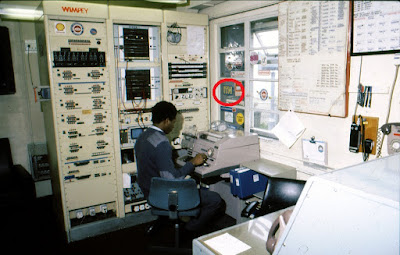The GPO had an important role in setting up Saxa Vord and in
maintaining the units operational communications with the outside world. Right at the beginning in the
'50s they erected a VHF system on the Ward of Norwick, by the Transmitter site,
to provide telephone links from Unst to Lerwick for the RAF. A separate
GPO building was constructed on the Ward
and it can be seen in this Tony Sparkes photo from 1965:
The discovery and exploitation of oil in the seas around Shetland brought many changes to the Isles. New jobs, both on and off shore were created, transport links were enhanced and communications improved. Whilst the majority of the land-based changes occurred on the Shetland Mainland, there were knock on effects on most of the other Islands. On Unst the most obvious change was the development of the small airstrip into what was to become (in aircraft movement numbers) one of the busiest UK regional airports – 138,388 passengers were recorded in transit during 1980 alone.
One of the less well known changes on Unst happened at the
GPO Building by the Transmitter Site. In Feb 1972 a Mr Crocker from HQ 90 Gp,
together with a team from the GPO Marine Division, arrived at Saxa Vord to
prepare for the setting up of a radio relay link between the UK mainland (Wick)
and North Sea Oil Rigs. Most of the terminal equipment was to be installed by
GPO engineers; however, it was to be operated by RAF staff. This required a
major extension to the GPO Building. Four servicemen were sent to the Post
Office receiving station at Bearley, near Stratford upon Avon, to attend a 4
day training course.
The first operational channel, telephony, was operated by Comms personnel on 8 Nov 72 whilst the GPO engineers continued to work on the telegraphy channels. The Unit callsign was GNK, Gulf-November-Kilo. The first telegraphy channel became operational in Jan 73. Two articles which appeared in the press at this time are reproduced below:
.jpg)

Traffic on the network grew steadily; by Jul 73 nine Oil Rigs were using the facility. As far as I can tell there had been no increase in the RAF staff to handle the Radio Norwick workload and the Engineering Section were recording the hours spent on unscheduled maintenance of the equipment. In Jan 74 visiting GPO engineers let it be known that there were plans to more than double the amount of installed equipment. By June of 1974 there were 16 Oil Rigs using the circuit and in October the Unit put in a bid to Headquarters Strike Command for an increase in the L Fitt GC establishment in light of the Radio Norwick workload. Unusually, the bid for more personnel was handled quickly and without any apparent argument. By Jan 75 new staff had arrived and I can only assume that the contract with the GPO was financially rewarding for the RAF!
In Mar 75 some of the new GPO equipment, known as System 2, came on line (if anyone can tell me what this did I’d appreciate it). This was followed in Jun 75 by a SITOR facility – this provided for discrete 2 way telex between Oil Rigs, pipe-laying barges and oil companies. In the period from Jun to Dec 75 the number of Rigs using the circuits fluctuated between 15 and 20.
In the 80’s the site on the Ward of Norwick looked like this:
There appear to have been 8 large HF masts associated with the GPO/BT installation near the RAF Transmitter Site and a single mast at the Receiver site – as shown in the next (poor quality) picture.
The next 2 posed photos show Saxa Comms personnel in “Radio Norwick”. The Radio Norwick Building was normally unmanned, unless there was a fault to be repaired. The photos were actually taken in the office in the RAF Transmitter Building where various patch equipment was stored and it also contained a teleprinter. I've marked an ITN sticker which is in both pictures which I think were taken some years apart. The teleprinter was used to communicate with the oil rigs or with the offices of the oil companies and was essential for testing and fault rectification.
It was a remote site for the comms staff, very isolated in winter, but the summer views occasionally compensated.
The equipment was improved as time went by and Radio Norwicks life continued for more than 20 years. I don’t know when the installation closed down, it may have been replaced by newer technology or else the run-down at Saxa meant there was no one left to maintain it. The masts were still around the Transmitter site when this photo was taken in 1996:
Last year Pete Brindley managed to gain access to the building (the door was open!). Pete had done 3 stints at Transmitters over the years, including some time working with Radio Norwick. Luckily he had his camera with him and I have reproduced a few of his photos below.
Pete also took this photo showing the base of one of the aerial masts:
The next 2 photos have come from Ronnie Robertson (ex
GPO/BT), who was involved with Saxa in the mid '70s and then again from the
'90s until the unit closed.
After sitting empty for many years the site of Radio Norwick was put on sale by MOD in Jun 2012. I believe it sold for £3,500 – the building looks watertight and it would make a scenic summer retreat. Personally I’d look for somewhere more accessible in the winter. The last photo was taken in Sep 2011.
Acknowledgements:-
Thanks to the following for their help with this section:
Pete Brindley
Steve Harrison
Ronnie Robertson
Tony Sparkes
Tom Worthington
CONTENTS LIST











.jpg)





















+-+Copy.JPG)
